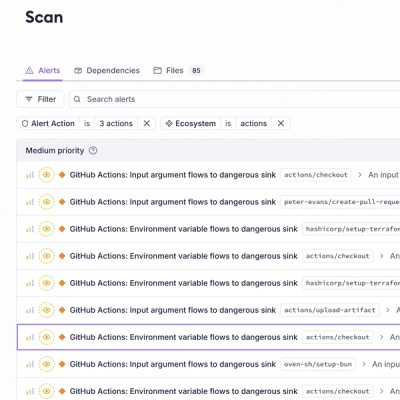
Product
Introducing Socket Firewall Enterprise: Flexible, Configurable Protection for Modern Package Ecosystems
Socket Firewall Enterprise is now available with flexible deployment, configurable policies, and expanded language support.
@cher-ami/transitions-mananger
Advanced tools
Transitions manager allows to handle and dispatch transition states from anywhere in the application



Transitions manager allows to handle and dispatch transition states from anywhere in the application.

npm i @cher-ami/transitions-manager
Create a new transitionsManager instance, as static, on a React component.
Then, when handle the manager play state with usePlayIn and usePlayOut hooks.
Header.transitionsManager = new TransitionsManager()
function Header() {
usePlayIn(Header.transitionsManager, async (done) => {
await myPlayIn()
done()
})
usePlayOut(Header.transitionsManager, async (done) => {
await myPlayOut()
done()
})
return ...
}
Now, from anywhere in the application, you can play the component via his own transitionsManager instance.
await Header.transitionsManager.playIn()
// now, the transtion is done.
Header.transitionsManager.playIn() will exectute the transition function of usePlayIn hook defined previously in Header component.
This method return a promise that will be resolved when the transition is done with done() function from the same hook.
Of course, "awaiting" the promise is not mandatory.
Instead of handle the transitionsManager play state with usePlayIn and usePlayOut hooks,
you can use the useTransitionsManager hook in your component.
This one returns the current play state of the transitionsManager instance when it changes.
In this case, you have to execute the playInComplete and playOutComplete functions when the transition is done.
useTransitionsManager(Header.transitionsManager, async (playState) => {
if (playState === "play-in") {
await myPlayIn()
Header.transitionsManager.playInComplete()
}
if (playState === "play-out") {
await myPlayOut()
Header.transitionsManager.playOutComplete()
}
})
At this point, the component is eable to be play-in and play-out by his own transitionsManager instance from anywhere in the application. It's also possible to mount and unmount before and play-in and after play-out.
By using useIsMount hook from the parent component, you can check the mount and unmount boolean state to condition the rendering.
const App = () => {
const mountHeader = useIsMount(Header.transitionsManager)
return <div>{mountHeader && <Header />}</div>
}
Now, you can mount and unmount the component.
await Header.transitionsManager.mount()
await Header.transitionsManager.playIn()
// ...
await Header.transitionsManager.playOut()
await Header.transitionsManager.unmount()
Writting all the process is a bit long, but you can use the manager in a more simple way.
If you don't want to specify each time mount and unmount methods, you can pass autoMountUnmount param to true in the constructor.
Header.transitionsManager = new TransitionsManager({ autoMountUnmount: true })
playIn method will call mount methods before is execution, and playOut will call unmount methods after is execution automatically.
With autoMountUnmount, it will get the same result as in the previous example with that code:
await Header.transitionsManager.playIn() // auto mount + playIn
// ...
await Header.transitionsManager.playOut() // playOut + auto unmount
@wbe/debug is used on this project. It allows to easily get logs informations on development and production modes.
localStorage.debug = "TransitionsManager:*"
Header.transitionsManager = new TransitionsManager({ name: "Header" })
mount(): Promise<void>
mountComplete(): void
unmount(): Promise<void>
unmountComplete(): void
playIn(): Promise<void>
playInComplete(): void
playOut(): Promise<void>
playOutComplete(): void
npm i
Start dev server
npm run dev
FAQs
Transitions manager allows to handle and dispatch transition states from anywhere in the application
We found that @cher-ami/transitions-mananger demonstrated a not healthy version release cadence and project activity because the last version was released a year ago. It has 4 open source maintainers collaborating on the project.
Did you know?

Socket for GitHub automatically highlights issues in each pull request and monitors the health of all your open source dependencies. Discover the contents of your packages and block harmful activity before you install or update your dependencies.

Product
Socket Firewall Enterprise is now available with flexible deployment, configurable policies, and expanded language support.

Security News
Open source dashboard CNAPulse tracks CVE Numbering Authorities’ publishing activity, highlighting trends and transparency across the CVE ecosystem.

Product
Detect malware, unsafe data flows, and license issues in GitHub Actions with Socket’s new workflow scanning support.